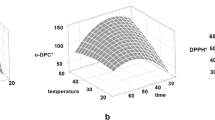Abstract
Phenolic compounds are of fundamental importance to the shelf life of virgin olive oils because of their antioxidative properties. In this paper, the evolution of simple and complex olive oil phenols during 18 mon of storage is studied by high-performance liquid chromatography (HPLC) analysis. The olive oils under examination were from various olive cultivars, harvested in two sectors in the same region at different stages of ripeness. The findings indicate that it is not the variety but rather the ripeness of the olives and the soil and climate that influence the phenol composition of virgin olive oil. In addition, a positive correlation was found between the age of the oils and the tyrosol to total phenols ratio. Lastly, gas chromatography-mass spectrometry analysis confirmed that the unidentified peaks detected by HPLC were of a phenolic nature.
Similar content being viewed by others
References
Vazquez Roncero, A., C. Janer del Valle, and M.L. Janer del Valle, Polyphenols Content and Stability of Olive Oils, Grasas Aceites 26:14–18 (1975).
Gutierrez Gonzales-Quijano, R., C. Janer del Valle, M.L. Janer del Valle, F. Gutierrez Rosales, and A. Vazquez Roncero, Relationship Between Polyphenol Content and the Quality and Stability of Virgin Olive Oil, Ibid.:101–106 (1977).
Montedoro, G., Phenolic Substances Present in Virgin Olive Oil. Note I: Identification of Phenolic Acids and Their Antioxidant Power, Sci. Tecnol. Aliment. 2:177–186 (1972).
Perrin, J.L., Les Composés Mineurs et les Antioxigénes Naturels de l’Olive et de Son Huile, Rev. Franç. Corps Gras 39:25–32 (1992).
Vazquez Roncero, A., Les Polyphénols de l’Huile d’Olive et Leur Influence sur les Caractéristiques de l’Huile, Ibid.:21–26 (1978).
Solinas, M., L. Di Giovacchino, and A. Mascolo, I Polifenoli Delle Olive e Dell’Olio di Oliva. Nota IV: Loro Evoluzione in Dipendenza Dei Processi Ossidativi Primari Che Intervengono Nel Corso Della Conservazione Dell’olio, Ann. 1st. Sper. Elaiotec. (Pescara) 8:3–9 (1978).
Chimi, H., A. Sadik, B. Le Tutour, and M. Rahmani, Contribution à l’Étude Comparative des Pouvoirs Antioxydants dans l’Huile d’Olive du Tyrosol, de l’Hydroxytyrosol, de l’Acide Caféique, de l’Oleoeuropéine et du BHT, Rev. Franç. Corps Gras 35:339–344 (1988).
Chimi, H., M. Rahmani, J. Cillard, and P. Cillard, Autooxidation des Huiles d’Olive: Role des Composés Phénoliques, Ibid.:363–367 (1990).
Papadopoulos, G., and D. Boskou, Antioxidant Effect of Natural Phenols on Olive Oil, J. Am. Oil Chem. Soc. 68:669–671 (1991).
Papadopoulos, G., M. Tsimidou, and D. Boskou, Stability of Virgin Olive Oil, Assessment of Natural Antioxidants and Other Related Factors, Dev. Food Sci. 32:321–326 (1993).
Cortesi, N., M. Azzolini, P. Rovellini, and E. Fedeli, I Componenti Minori Polari Degli Oli Vergini di Oliva: Ipotesi di Strutura Mediante LC-MS, Riv. Ital. Sostanze Grasse 72:241–251 (1995).
Angerosa, F., N. d’Alessandro, P. Konstantinou, and L. Di Giacinto, GC-MS Evaluation of Phenolic Compounds in Virgin Olive Oil, J. Agric. Food Chem. 43:1802–1807 (1995).
Angerosa, F., N. d’Alessandro, F. Corana, and G. Mellerio, Characterization of Phenolic and Secoiridoid Aglycons Present in Virgin Olive Oil by Gas Chromatography-Chemical Ionization Mass Spectrometry, J. Chromatogr. in press, 1996.
Cantarelli, C., Polyphenols in the Fruit and in Olive Oil, Riv. Ital. Sostanze Grasse 38:69–72 (1961).
Montedoro, G.F., and L. Garofalo, The Qualitative Characteristics of Virgin Olive Oils. The Influence of Variables Such as Variety, Environment, Preservation, Extraction, Conditioning of the Finished Product, Ibid.:157–168 (1984).
Amiot, M.T., A. Fleuriet, and J.T. Macheix, Importance and Evolution of Phenolic Compounds in Olive During Growth and Maturation, J. Agric. Food Chem. 34:823–826 (1986).
Solinas, M., HRGC Analysis of Phenolic Components in Virgin Olive Oils in Relation to the Ripening and Variety of Olive, Riv. Ital. Sostanze Grasse 64:255–261 (1987).
Bruni, U., P. Fiorino, and N. Cortesi, Influence of Agricultural Techniques, Cultivar, and Area of Origin on Characteristics of Virgin Olive Oil and on Levels of Some of Its Minor Components, Olivae 53:28–34 (1994).
Zunin, P., F. Evangelisti, M.A. Pagano, E. Tiscornia, and R. Petacchi, Phenolic Compounds in Oil Obtained from Olea europea and Anti-Dacus Treatments, Riv. Ital. Sostanze Grasse 72:55–59 (1995).
Solinas, M., L. Di Giovacchino, and A. Mascolo, The Polyphenols of Olives and Olive Oil. Note III: Influence of Temperature and Kneading Time on the Oil Polyphenol Content, Ibid.:19–23 (1978).
Fedeli, E., and N. Cortesi, Qualità, Provenienza e Tecnologia Degli Oli di Oliva Vergini, Ibid.:419–426 (1993).
Di Giovacchino, L., M. Solinas, and M. Miccoli, Effect of Extraction Systems on the Quality of Virgin Olive Oil, J. Am. Oil Chem. Soc. 71:1189–1194 (1994).
Cinquanta, L., M. Esti, and G. Gambacorta, Evoluzione dei Composti Fenolici in Oli Extra-Vergine di Oliva Prodotti con Differenti Tecnologie, in Ricerche e Innovazioni Nell’industria Alimentare, Vol. II, edited by S. Porretta, Chiriotti Editori, Pinerolo, 1996, pp. 916–924.
Italian Official Method of Analysis of Oils and Fats, Istituto Poligrafico dello Stato, Roma, 1964, pp. 37–39, 69–70, 89–93, 93–95.
Montedoro, G., M. Servili, M. Baldioli, and E. Miniati, Simple and Hydrolyzable Phenolic Compounds in Virgin Olive Oil. 1. Their Extraction, Separation, Quantitative and Semi-Quantitative Evaluation by HPLC, J. Agric. Food Chem. 40:1571–1576 (1992).
Amiot, M.T., A. Fleuriet, and J.T. Macheix, Accumulation of Oleuropein Derivatives During Olive Maturation, Phytochemistry 28:67–69 (1989).
Amiot, M.T., A. Fleuriet, and J.T. Macheix, Importance and Evolution of Phenolic Compounds in Olive During Growth and Maturation, J. Agric. Food Chem. 34:823–826 (1986).
Cortesi, N., E. Fedeli, and E. Tiscornia, I Componenti Polari Degli Oli di Oliva. Possibili Utilizzazioni Analitiche, Nota I, Riv. Ital. Sostanze Grasse 62:281–286 (1985).
Author information
Authors and Affiliations
Corresponding author
About this article
Cite this article
Cinquanta, L., Esti, M. & Notte, E.L. Evolution of phenolic compounds in virgin olive oil during storage. J Amer Oil Chem Soc 74, 1259–1264 (1997). https://doi.org/10.1007/s11746-997-0054-8
Received:
Accepted:
Issue Date:
DOI: https://doi.org/10.1007/s11746-997-0054-8




